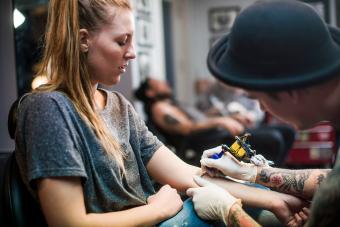
Have you changed your mind after getting a tattoo? According to an informal study, about one in four people who made a quick decision to get a tattoo, regret it within a few days. So what do you do when your permanent ink needs to be removed? Most people turn to laser tattoo removal as the safest way to remove the art.
Laser tattoo removal has improved to the point where you may often be able to replace your ink with clean, clear skin following the procedure. But following aftercare instructions is essential for proper healing.
Laser Tattoo Removal Aftercare: Day by Day
Laser tattoo removal is the use of an intense light beam to break up tattoo inks. The treated area may feel like a mild burn at first, but standard aftercare will soothe it and protect the wound from germs. You may notice a sudden whitening of the area, but it quickly subsides, according to the University of Rochester Medicine (UR Medicine).
Bruising or swelling happens for some people. Crusty patches, blisters, or scabs can form within the first eight to 72 hours and last up to 2 weeks or more. All traces of the procedure are typically healed in about four weeks. Here is what happens during that time.
Day 1
The first few days in the healing process take the most care. Make sure to follow your technician's instructions to the letter.
- Keep a sterile gauze bandage over the treated area until the wound is healed.
- Reapply a very thin coating of antibiotic ointment or a healing salve recommended by your laser technician or healthcare professional each time you change the gauze. Some clinics advise you to use petroleum jelly or moisture barrier ointments such as Aquaphor or aloe vera gel.
- Aim for ointment re-application three times a day for the first three days.
- If you are really uncomfortable or the area shows signs of being inflamed or slightly swollen, apply cool compresses.
- You may shower, if necessary, after two or more hours post-treatment.
- No high-pressure blasts of water and no soaking - no baths, saunas, hot tubs, or swimming until the area has completely healed.
Days 2-3
After the first day, the wound should calm down a bit. You typically don't need the ice packs anymore.
- No physical exertion is recommended for 2-7 days after the treatment.
- Don't shave, wear make-up, or apply creams on or near the treated area.
- Laser treatments are drying, and the area may become itchy. Apply vitamin E ointment, Aquaphor, hydrocortisone cream, or a similar product as a moisturizer to prevent and soothe itching.
- Blisters can erupt anytime from 8 to 72 hours after laser treatment. Don't touch them, but do keep applying the antibiotic or moisture barrier cream.
Day 4 to 4 Weeks
At around the four-day mark, you might be feeling pretty good. But it's still important to care for your skin regularly.
- Remove the bandage and clean the treated area with mild soap and water, patting it dry.
- Keep the area dry and clean while it heals.
- Apply ointment for at least 10-14 days.
- Avoid extra-sweaty or dirty activities and overexertion that could stress the area and prevent scabbing and healing.
- Keep popped blisters covered in a light film of protective ointment for at least 24 hours after they pop to prevent infection.
- Never scratch or scrape a scab. It could cause scarring, and it could lead to infection.
- Once the gauze bandage is off, use sunscreen over the treated area every time you are outdoors for at least three months. Even cloudy days are too much sun exposure for a lasered-away tattoo. SPF 25 is the absolute minimum strength for sunblock, but higher is better.
- Check for signs of infection. Redness, tenderness, and heat around the treated area could signal a problem. If the area is oozing, crusted over with a yellow or honey-colored crust, or shows spreading redness, you should see your doctor.
- If you have any unusual reaction to the treatment or during aftercare, check in with your medical provider.
How Long It Takes to Laser Tattoo Removal to Heal
After four weeks, you should be entirely healed - or very near. It can take up to eight weeks for the area to be completely healed, depending on your physical health and how elaborate the removal was. If you follow aftercare instructions meticulously, you will speed the healing and ensure the area looks as pristine as possible. But complete removal takes multiple treatments.
How many treatments you'll need depends on the age of the tattoo, the colors of the inks used, the size and location of the tat, and other factors. If you're lucky, the whole process results in little to no trace that there was once a tattoo. However, you may need to schedule repeat visits at 8-week intervals to get there.
Be aware that some people are prone to keloids (raised scar tissue), and black skin tends to scar more easily than lighter skin, according to the American Academy of Dermatology. Take extra precautions if you have delicate skin, and ask your laser technician about any additional salves or healing treatments you might employ.







